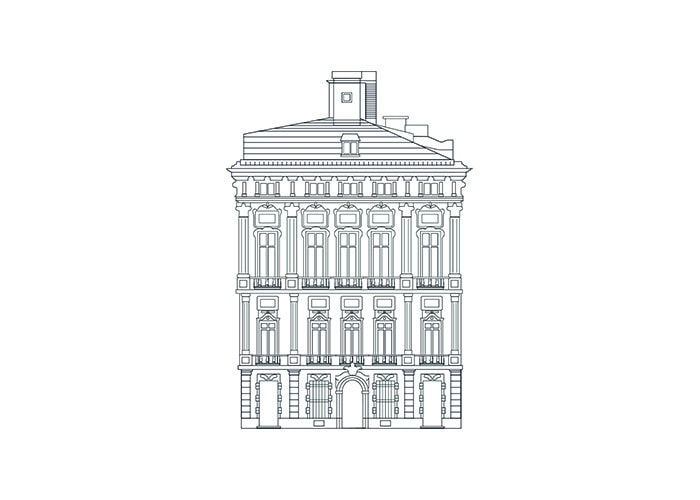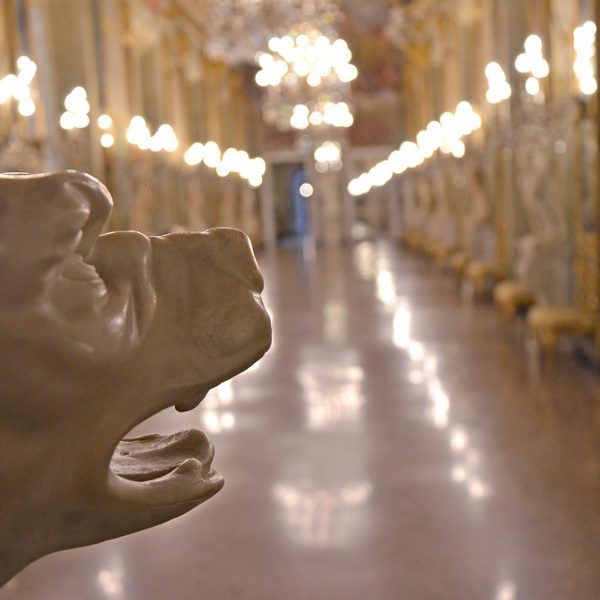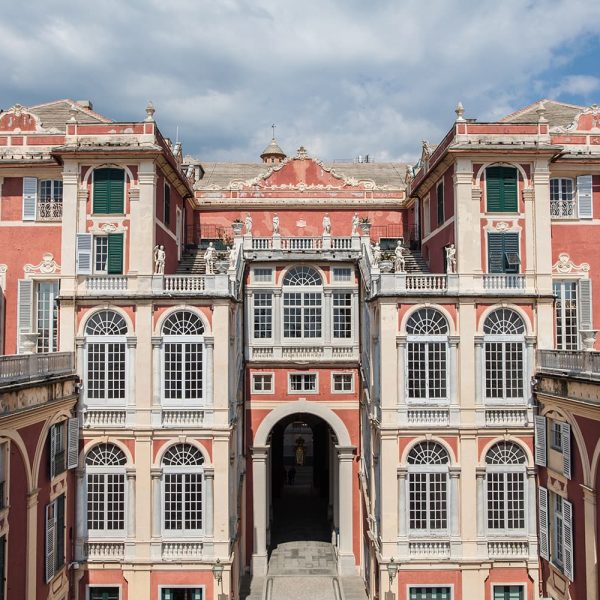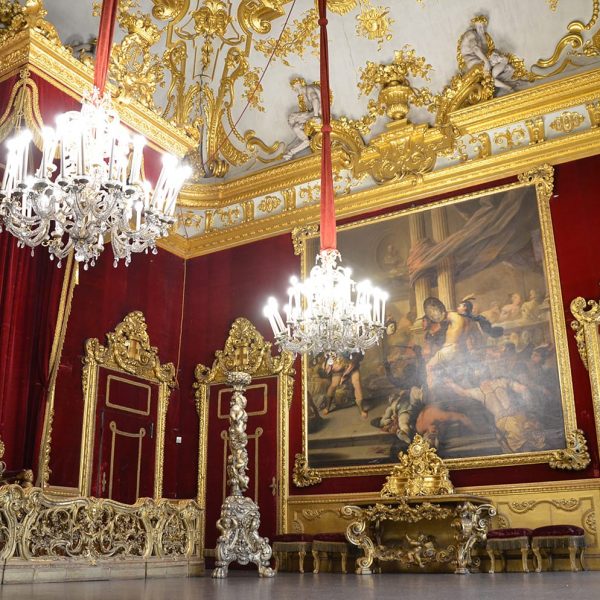
29. Palace of Francesco Maria Balbi Piovera
25 March 2022
31. Palace of Cosmo Centurione
25 March 2022Palazzo Reale is a grand aristocratic residence, built and extended over time and splendidly decorated by two great Genoese dynasties, as well as by the Savoys: these Balbi and Durazzo families; its history hence consists of three main building phases.
The history of the palazzo started on 4th February 1643 when Stefano Balbi presented the project for the impressive building to be constructed facing the church of San Carlo. The architects mentioned in the sources are Pier Francesco Cantone and Michele Moncino, who were subsequently joined by Giovanni Angelo Falcone. A large part of the central body of the current building, together with the west gallery and so-called “separate building” along the vico della Pace can be traced back to this first phase, which was completed in about 1650. The Seventeenth Century layout of the construction was then restricted to the current central body, organised, just like today, over two half-floors, with two short wings constricting the courtyard of honour toward the sea, and the west section joined with the main body.
The decoration of the rooms was entrusted not only to the most prized artists on the Genoa scene such as G. B. Carlone, together with up and coming young painters such as Valerio Castello, but also A. M. Colonna and A. Mitelli from Bologna. Between 1677 and 1679 the Palazzo passed to the Grillo family and was then sold to the Durazzo family which extended and decorated it with frescos, stucco decorations and very valuable pictures.
According to Ratti in 1705 Eugenio Durazzo called Carlo Fontana from Rome to give the complex a cohesive appearance. The Roman architect designed a stately atrium from which the monumental staircases lead off, giving direct access to the second piano nobile, and a majestic terrace overlooking the sea bounding the courtyard of honour and separating it from the hanging garden with a triple arcade.
The stunning solution of the palazzo’s interior façade, a delightful contrast to the more austere façade on Via Balbi, is certainly the most striking mark left by Fontana on the Genoa residence.
During the Durazzo period of ownership the old west picture gallery, commissioned by G. B. Balbi in 1650, was transformed into the new Gallery of Mirrors, with D. Parodi’s design influenced both by the Roman models of the grand galleries of Palazzi Colonna and Doria Pamphilj, and the French models, particularly the Galerie de Glaces in the Palace of Versailles.
Some of the frescoed rooms were altered to accommodate new paintings which adorned one of the most prestigious picture galleries in the city, which already boasted masterpieces by L. Giordano, P. Veronese, J. Tintoretto, A. Van Dyck and P. P. Rubens, as well as Genoa’s grand masters.
At the start of the XIX century the indirect heirs of this branch of the family, which had died out in 1809 with the death of Girolamo Luigi Durazzo, decided to sell the residence. In actual fact, it is said that Girolamo Luigi himself had already made the decision; it is known, in fact, that the first person interested in buying it was Napoleon Bonaparte, who was a guest in the palazzo in 1805: in 1808 the Emperor’s functionaries prepared a report illustrating the qualities of the via Balbi residence, which was hence already available for sale.
Finally, in 1823, after negotiations started in 1816, the Durazzo family sold the building to the Savoy family; the King of Sardinia Carlo Felice ordered major new restoration, decoration, maintenance and alteration works to be carried out on the apartments for their new royal use.
In 1831, on the king’s death, the Palazzo passed to Carlo Alberto: most of the alteration works carried out on the building for palace purposes were completed during the Carlo Alberto period. These works included new stables and riding school, the fitting out of the Throne Room, Audience Room and Ballroom, originally a grand antechamber for accessing the floor that had accommodated Durazzo family portraits and two large canvases with the “The legation of Giovanni Agostino Durazzo at the court of the sultan” now dispersed, and which was newly adorned with stucco decorations, in the neo-classical style. A state apartment was fitted out on the first floor, currently known as the Apartment of the Duke of the Abruzzi, the old theatre, the Teatro del Falcone, annexed to the residence, was restored and a covered passage was constructed joining the palace to the church of San Sisto on via Prè and the Darsena Palace, passing over the roadway (then named after Carlo Alberto, but now via A. Gramsci) with a bridge.
The artists called by the Savoys to decorate the new rooms were amongst the most highly respected professors of the local Accademia Ligustica: M. Canzio, S. Varni, G. Frascheri, C. M. Danielli and G. Isola. The wood marquetry floors decorating some of the rooms, probably the result of the collaboration between Pelagio Pelagi (Bologna 1775-1860) and the English cabinet-maker Henry Peters, also date back to this period.
And so during the XIX century the kings of Sardinia and then of Italy resided alternately in this new Savoy palace, until Vittorio Emanuele III sold it in 1919, together with other royal residences, to the Italian State.
On 30 April 1920 Palazzo Reale passed to the Ministry of Education which placed it under the management of the then Undersecretary for Antiquities and Fine Arts. The second piano nobile of the palazzo is now used as a public museum under the management of the Commission for Architectural Heritage and the Ligurian Countryside.
The Palazzo Reale Museum is on the second piano nobile of the residence, which has conserved its interior reception areas intact, complete both with the fixed decorations: frescos and stucco decorations, and movable adornments: pictures, sculptures, furniture and household items.
The prestigious picture gallery, in particular, reflects the acquisitions made by the different owners of the residence, starting with Giovanni Battista Balbi, a great collector and connoisseur of art, then by the Durazzo family, Eugenio, Gerolamo and Marcellino primarily, up to the Savoy dynasty. In 1821 Carlo Felice purchased an important Genoese collection of old paintings (mainly from the XVII century) and most of those found in the Palazzo originate from that important source.
The three main historical identities of the residence, which often co-exist and complement one another, are always the source of a highly original variety of features and extraordinary richness: the miraculous co-existence of very high quality works of art alongside everyday household items means that the visitor can move through the rooms of the Museum and get a real feel for the Past.
- PH: Comune di Genova
- PH: Xedum
- PH: Xedum
- PH: Comune di Genova
- PH: Comune di Genova








